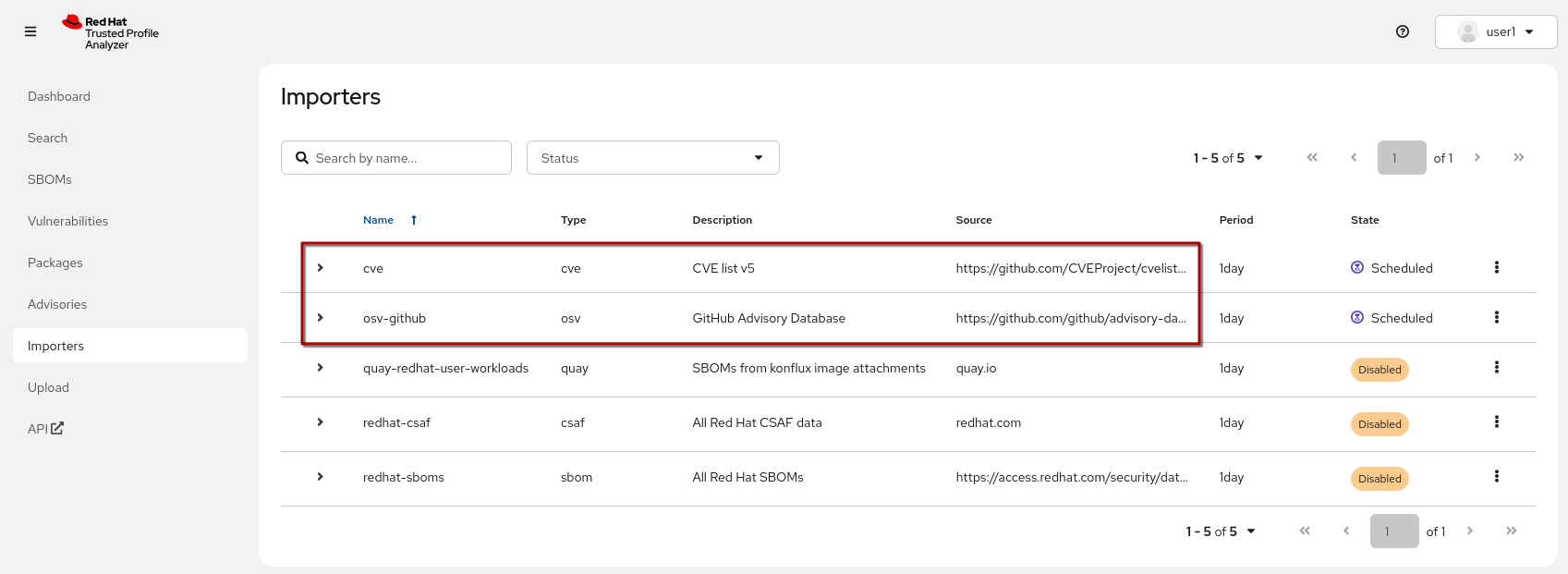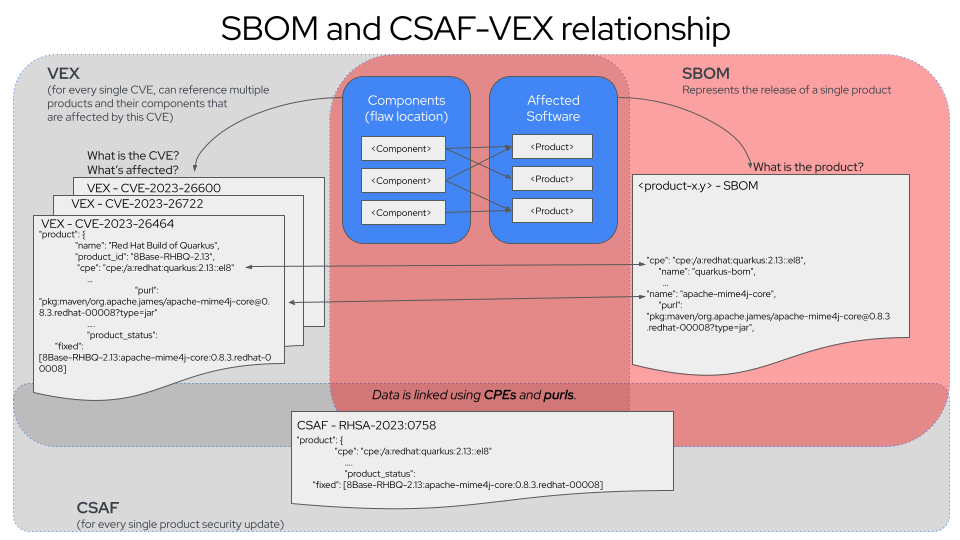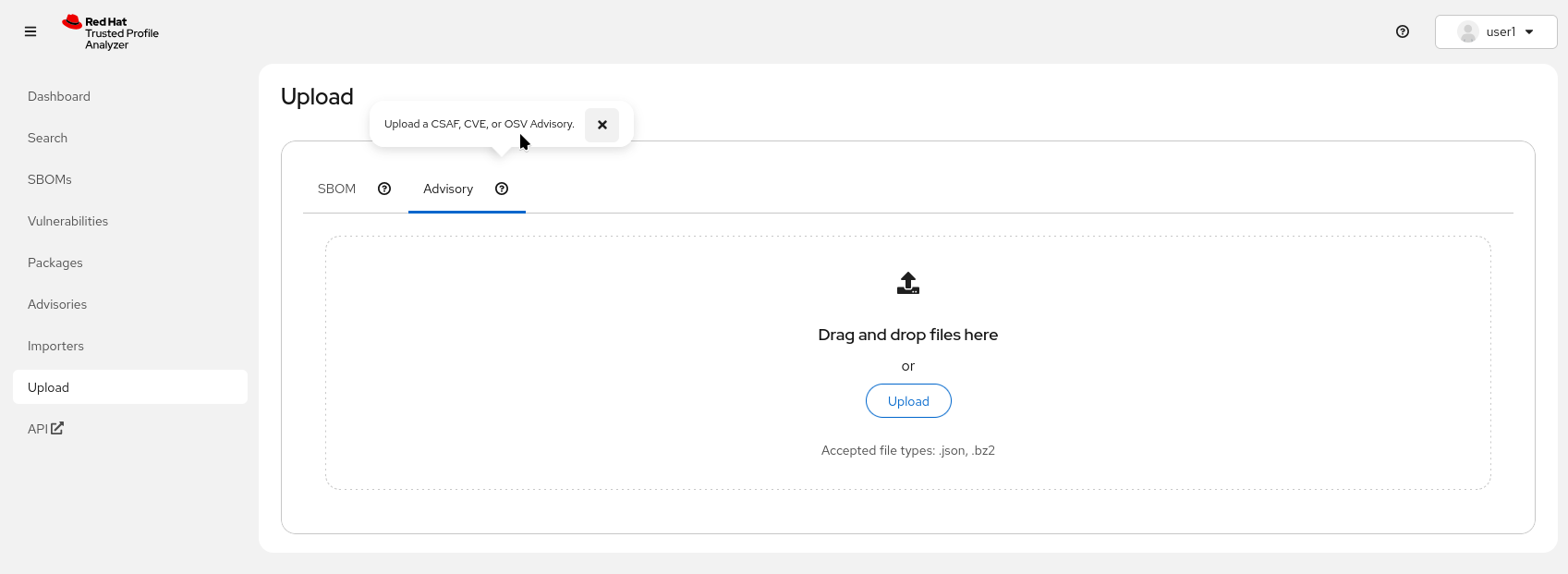The correlation challenge
Vulnerability Data (CVE)
The primary information source that tells us if a package (as part of an SBOM) is vulnerable is the CVE (Common Vulnerabilities and Exposures).
TPA imports this data from two sources

1) The CVE Program database
|
Red Hat has been appointed CNA, CNA-LR and root roles in the CVE program:
|
2) The GitHub Advisory Database
Aggregates CVEs plus security advisories from
-
Security advisories reported on GitHub
-
The National Vulnerability Database
-
The npm Security Advisories Database
-
The FriendsOfPHP Database
-
The Go Vulnerability Database
-
The Python Packaging Advisory Database
-
The Ruby Advisory Database
-
The RustSec Advisory Database
Identification
There are two attributes by which a package and its version can be matched to CVE information: ("log4j-core version 2.13.1 is affected"):
Both sources above support these identifiers for CVEs.
Identifiers in SBOMs:
Both major SBOM formats support multiple identifier types:
CycloneDX:
-
Supports three fields for vulnerability identification: CPE, PURL, and SWID
-
CPE for operating systems/applications/hardware, SWID for installed software, and PURL for software package metadata
SPDX:
-
SPDX 2.2+ supports PURL as an external reference, and SPDX 3.0 promotes PURL more prominently
-
Also supports CPE via ExternalRef fields
-
Includes document-specific internal identifiers (SPDXID) for tracking relationships
What’s missing?
With
-
SBOMs listing packages and versions
-
CVE data listing affected packages
and both (SBOMs and CVE data) having enough data in common to successfully match - there isn’t anything missing, is there?
What is missing is Context information, especially if related to software artifacts ("products") procured from vendors.
A simple mapping will tell you - here’s a product (an SBOM) that has this vulnerability (a vulnerable component).
A vendor could give you additional context, though:
-
yes, it contains this vulnerability, but we are not using it in an exploitable fashion
-
yes, it contains this vulnerability, but we have otherwise contained it
-
yes, it contains this vulnerability, but we have patched it from product version xyz+
Similarly, in larger enterprises, development teams could provide that information for transparency and compliance reasons, such as
-
yes, we know package xyz is vulnerable but only if configured in a specific manner that we are not using.
VEX to give Context
CSAF (Common Security Advisory Framework) VEX files (Vulnerability Exploitability eXchange) provide context focusing on the exploitability of CVEs in a product context - effectively reducing the number of false positives.
Vendor Advisories (such as Red Hat Advisories "RHSA-2025:1234") use this format to provide additional context and fix status to users of their software.
Understanding the SBOM and CSAF-VEX Relationship
The diagram illustrates how SBOMs, VEX and CSAF-VEX are mapped and provide answers to
-
"What’s in this product?"
-
"What’s affected by this CVE?"
SBOM - "What’s in this product?"
An SBOM represents the release of a single product and lists all its components.
Here:
-
Product: "quarkus-bom"
-
Contains component: "apache-mime4j-core" version 0.8.3
The SBOM answers: "This release of our product contains these specific components and versions."
VEX - "What’s affected by this CVE?"
A VEX document is organized around one or more CVEs and identifies which products/components are affected by that specific vulnerability. It’s a vulnerability-centric view.
Example from diagram:
-
CVE-2023-26464 affects "Red Hat Build of Quarkus"
-
The vulnerable component is "apache-mime4j-core" (found in RHBQ 2.13)
-
Status: "fixed" in version 0.8.3
The VEX answers: "This CVE affects these specific products, and here’s the fix status."
The key insight: A single vulnerable component (like apache-mime4j-core) can appear in multiple products, and a single CVE can affect multiple products that all use that component.
How They Link Together: CPEs and PURLs
-
SBOM lists components with identifiers:
-
CPE:
cpe:/a/redhat:quarkus:2.13::el8 -
PURL:
pkg:maven/org.apache.james/apache-mime4j-core@0.8.3:redhat-00008?type=jar
-
-
VEX references the same identifiers:
-
Uses the same CPE/PURL to identify which component in which product
-
Adds vulnerability status information
-
-
CSAF adds Vendor Advisory Context
-
CSAF-RHSA-2023:0758 is the security advisory document
-
References both the product (via CPE) and the component status
-
Shows the fixed version
-
CSAF files — representations of a single product release along with the CVEs that it fixes and the components that it ships — allow consumers to keep their SBOM up-to-date beyond its initial release.
SBOM files are static documents that contain a listing of components in a specific version of a product. For example, the RHEL 9.2 release has an accompanying SBOM that lists all components shipped by default in that release. Any security advisories released after RHEL 9.2 will update specific packages and provide information about component upgrades from those shipped in the 9.2 GA (generally available) version.
VEX files then provide a listing of affectedness of a CVE to each and every product release. For example, a VEX file of a hypothetical CVE-2099-1000 would contain information about whether or not RHEL 9.2 is affected by the vulnerability tracked by this CVE.
Example Chain
Let’s trace through the example in the diagram:
-
A vendor releases a product:
-
Creates SBOM: "quarkus-bom contains apache-mime4j-core v0.8.3"
-
-
A vulnerability is discovered:
-
CVE-2023-26464 is published affecting apache-mime4j-core in earlier versions
-
-
VEX provides exploitability context:
-
"CVE-2023-26464 affects Red Hat Build of Quarkus"
-
"The vulnerable component is RBase-RHBo 2.13:apache-mime4j-core:0.8.3:redhat-0008"
-
"Status: FIXED in version 0.8.3"
-
-
CSAF publishes product advisory and updates:
-
RHSA-2023:0758 describes the complete security update
-
References the product and fix details
-
Why This Matters
Without VEX: You might scan your SBOM and see apache-mime4j-core listed. A vulnerability scanner might flag CVE-2023-26464, causing alarm.
With VEX: The vendor can tell you: "Yes, we use that component, but this CVE is already fixed in our version" or "This CVE doesn’t affect how we use this component." This dramatically reduces false positives.


